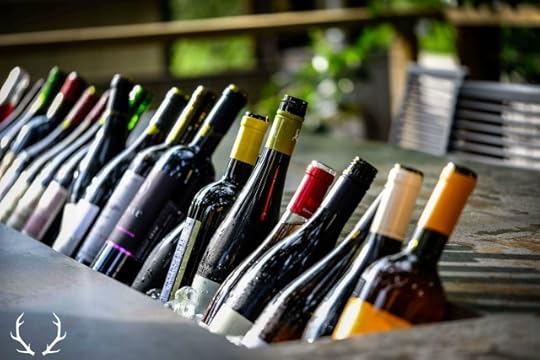Mark Sisson's Blog, page 131
August 15, 2018
Protein Intake While Keto: Why It Matters, How Much to Eat, and What My Intake Looks Like Now
 If you ask the average person, ketosis is primarily about carb restriction and fat intake. Go on a low-carb diet, eat more fat, allow your body to burn its own reserves. Pretty straightforward. Ketones are supposed to replace glucose.
If you ask the average person, ketosis is primarily about carb restriction and fat intake. Go on a low-carb diet, eat more fat, allow your body to burn its own reserves. Pretty straightforward. Ketones are supposed to replace glucose.
But what do we make of protein? Some keto dieters avoid it like the plague, worried anything more than a quarter pound of animal flesh will knock them back into sugar-burning purgatory. Some have even likened it to “chocolate cake.” Others eat it freely. Who’s right?
Well…
The most restrictive therapeutic ketogenic diets, the ones used to treat childhood intractable epilepsy, are very low protein—around 5-10% of calories. These diets are designed to maximize ketone production. Any more protein than that and those kids might not make enough ketones to treat their condition.
The most ketogenic state of all—fasting—is also very low in protein. Zero, to be exact.
Okay, so protein can inhibit ketosis. Why? What’s going on?
One common assumption is that too much protein converts to glucose via gluconeogenesis. This is the “steak is just chocolate cake” hypothesis. It makes sense and sounds reasonable. It’s also completely wrong.
It turns out that gluconeogenesis follows an “as needed” schedule. Our livers don’t just mindlessly produce glucose anytime protein reaches a certain threshold. Our livers convert protein into glucose when we—for whatever reason—need more glucose. Demand-driven, not supply-driven. Keto-adapted individuals running over 70% of their brain and most of their muscle on ketones don’t demand a whole lot of glucose. Even under “optimal conditions“—giving a bunch of adults who just fasted overnight a big dose of radio-labeled protein and then tracking its fate through the body—humans convert very little dietary protein into glucose.
This isn’t a real issue.
What Causes Protein To Inhibit Ketosis?
It all starts with the Krebs cycle, that metabolic pathway that converts fatty acids into useable energy. In a “normal” cycle, fatty acids are broken down into acetyl-CoA. The liver pairs acetyl-CoA with oxaloacetate to complete the cycle and produce ATP energy. That’s basic energy generation.
Without oxaloacetate, the Krebs cycle cannot continue. Without oxaloacetate, acetyl-CoA has a different energetic fate: conversion into ketones. Where does oxaloacetate come from?
Carbs, usually. But protein can also be a source. Like carbohydrates, protein has the potential to donate oxaloacetate during the Krebs cycle. The more protein you eat, the more oxaloacetate you’ll have ready and willing to inhibit ketogenesis. This is how protein inhibits ketosis. Not by increasing gluconeogenesis. Not by spiking insulin.
By donating oxaloacetate.
How Much Protein Can You Eat and Still Remain Keto?
It depends on your goals and requirements.
If you’re dealing with serious epilepsy, creeping dementia, general inflammation, or anything else that requires or may improve with deep ketosis, aim for a lower protein content (10-15% of calories). Get those high ketone levels, see how it feels, and see if that’s the protein intake for you. Start low, really revel in those high ketone readings.
If you’re losing weight (or trying to), eat closer to 15-20%. For you, the ketone readings aren’t the biggest focus. How you look, feel, and perform are your main concern. Eating slightly more protein will increase satiety, making “eating less” a spontaneous, inadvertent thing that just happens. It will also stave off at least some portion of the lean mass accretion that occurs during weight loss; you want to lose body fat, not muscle.
If you’re trying to gain large amounts of muscle, eat closer to 20-25%.
Why You Shouldn’t Over-Restrict Protein
Just don’t go below 15% of your calories unless you absolutely need to. There’s a bottom. Protein is an incredible essential macronutrient. Fat is plentiful, even when you’re lean. Carbs we can produce from protein, if we really must, or we can just switch over to ketones and fats for the bulk of the energy that would otherwise come from carbs. Protein cannot be made. We have to eat it.
If we stop eating dietary fat, we’ll burn what we have on our bodies and—to a point—get healthier.
If we stop eating carbs, we’ll burn through our glycogen stores and then get better at burning fat. And we’ll be healthier.
If we stop eating protein, our organs, muscles, and bones will atrophy. Our health will suffer.
Another reason it’s so important (and so satiating) is that protein contains the most micronutrients. Fat-soluble vitamins are great, but the real good stuff we like—the B vitamins, the minerals—come packaged with protein.
How I’ve Changed My Approach To Protein
I think I need less than I used to think I needed. I eat maybe 80-100 grams a day max now. Some days a fair amount less, some days a fair amount more.
I also don’t think about protein meal-to-meal or even day-to-day. I tend to think of protein averages over three- or four-day chunks. If I get 200-250 grams in three days, I’m good and it doesn’t matter when or how I got it.
I know I’m in protein-sparing mode. We usually think of ketones as glucose-sparing, and they are. Generating (and being able to utilize) enough ketones to replace a large portion of the rare and flighty glucose is an invaluable asset in diseases of dysfunctional brain glucose metabolism like Alzheimer’s. Ketones are also protein-sparing. For one, if we aren’t burning through glucose, we don’t need any extra.
I make sure to eat a significant amount of collagen. Collagen reduces amino acid requirements. It’s not enough by itself to stimulate muscle protein synthesis or provide the essential amino acids. It does help balance out muscle meat intake, reduce inflammation, improve sleep, speed up joint and connective tissue healing, and reduce the amount of protein I need to reach my nutritional goals.
Important to note, though…
I’ve been doing this fat-adapted thing for a long time. My body is finely tuned to this kind of diet. It’s what it expects. People who are on week 2.5 of their keto journey might not have the same dynamic and may need more protein.
Keep in mind, too, that I’m not actively trying to gain muscle mass. The name of the game (for me) is to maintain: my body comp, my physical performance, my organ reserve, my health, my basic functionality. If I got the urge to put on lean muscle, I’d increase my protein intake.
Final Takeaways For Considering Protein Intake
If you crave protein, you should eat it. Cravings for a natural, relatively unadorned food can usually be trusted.
Know there aren’t any hard-and-fast rules about protein and ketosis. Everyone’s different. “Modified ketogenic” diets—higher in carbs and protein—are still effective against epilepsy. In one study, obese men ate an ad libitum (they ate what and how much they wanted) ketogenic diet consisting of 4% carb, 30% protein, 66% fat. They got into and remained in ketosis and ended up losing more weight with less hunger than another group on a high-carb diet with the same amount of protein.
If you’re going to severely restrict a vital macronutrient like protein, you’d better have a good reason. You’d better be seeing measurable, obvious benefits that disappear when you eat more protein. Don’t wed yourself to the numbers or to the idea of a thing. Always ground your dietary excursions in tangible, verifiable feedback—both subjective and objective. Do what works. Don’t do what doesn’t work, even if it’s “supposed to” be working.
As always (especially if you’re using keto to address a medical condition), make sure to consult your doctor.
Now I’d love to hear from you. How does protein affect your ketogenic diet? Do you even notice—or consider the question—in your process?
Take care, everyone.
References:
Fromentin C, Tomé D, Nau F, et al. Dietary Proteins Contribute Little to Glucose Production, Even Under Optimal Gluconeogenic Conditions in Healthy Humans. Diabetes. 2013;62(5):1435-1442.
Johnstone AM, Horgan GW, Murison SD, Bremner DM, Lobley GE. Effects of a high-protein ketogenic diet on hunger, appetite, and weight loss in obese men feeding ad libitum. Am J Clin Nutr. 2008;87(1):44-55.
El-rashidy OF, Nassar MF, Abdel-hamid IA, et al. Modified Atkins diet vs classic ketogenic formula in intractable epilepsy. Acta Neurol Scand. 2013;128(6):402-8.
Mark Sisson is the New York Times bestselling author of The Keto Reset Diet and a dozen other healthy living books. He is one of the leading voices in the evolutionary health movement.

The post Protein Intake While Keto: Why It Matters, How Much to Eat, and What My Intake Looks Like Now appeared first on Mark's Daily Apple.



August 14, 2018
Primal Camping Meals: Weekend “Car Camping” Edition
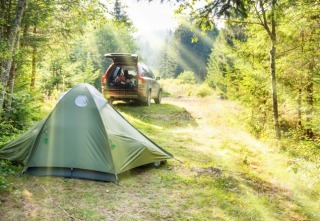 Most camp food is terrible or the opposite of Primal. Or both.
Most camp food is terrible or the opposite of Primal. Or both.
It’s either an expensive REI tetrapak full of wheat flour, dehydrated “meat,” and desiccated Crisco, a Dough Boy, or the entirely overrated s’more. I’ll get flak for that last one, but I don’t care. S’mores rarely live up to the hype past age 12.
Just because you’re living out of a tent doesn’t mean you have to settle for terrible, unhealthy, unappetizing food. If anything, you should be eating healthier when you camp. It feels corrosive to defile the sanctity and purity of the wild with processed junk food wrapped in plastic. You generate all this trash. Whole, Primal foods taste even better when you camp; packaged garbage somehow tastes even worse.
I’ll cover backpacking food in a future post, but car camping cookery is my specialty. That’s what I’ll cover today—the kind of weekend trip that allows for a sizable cooler, some extras flourishes, and more than a single cooking pot. There’s nothing better than turning your campsite into a full-fledged camp kitchen, creating hearty meals whose scents permeate the grounds, arousing jealousy and any nearby wandering bears. There’s something about serving up dark chocolate chili and a nice Malbec while the family next to you nibbles PopTarts, heats up the $12 freeze-dried dinner from REI, and plays their 20th game of “War.”
What are my go-to car camping favorites?
Sometimes I’ll just do the basics: eggs, bacon, a piece of meat or fish, some grilled asparagus.
More often, I’ll turn to my favorites….
The Hobo Pack
The hobo pack harkens back to those ancient days when hobos, tramps, and vagabonds of all sorts would travel the dusty roads and endless railroads of classic America carrying heavy duty aluminum foil pouches of meat, taters, and vegetables.
The hobo pack is versatile and forgiving. Anything works, and almost anything will end up tasting damn good. Create a pouch with two layers of aluminum foil. Fill the pouch with meat and vegetables. Place pouch on coals.
Pot Roast—beef, onion, carrot, garlic, salt, pepper, a little red wine.
Salmon—salmon, lemon, broccoli, butternut squash, salt, avocado oil.
Whatever you do, pair your meats and vegetables well. Fish cooks quickly, so you’ll want to include vegetables that cook quickly, too. Beef chuck takes longer, so you’ll want something heartier, like sweet potatoes.
Buried Winter Squash
My absolute favorite winter squash is the honeynut squash. It looks like a butternut squash, only about 1/3 the size and a deep orange. The taste is phenomenal.
Get a nice bed of coals going. Bury your squash in the coals and hot ash. Cover it on all sides.
When they’re soft and tender all over, pull them out. Brush off most of the soot and slice lengthwise. Scoop out the seeds.
They’re good plain, with a little butter, or even a scoop of chevre (soft goat cheese) and salt.
Shakshuka
First, make the harissa from this recipe. Set aside.
Heat up a dutch oven over the fire. Add olive oil, a few chopped garlic cloves, one chopped hot pepper, one chopped sweet pepper, and a tablespoon of ground cumin. Sub cayenne and sweet paprika if you don’t have fresh peppers. Cook until fragrant.
Add the harissa along with a can of crushed tomatoes (or the equivalent in fresh tomatoes, if you have access) and two teaspoons of tomato paste.
Reduce until thickened, salting to taste. When it tastes just right, make a few indentations in the sauce and crack an egg in each. I aim for at least 6 or 7 eggs.
Cover and cook until eggs are cooked to your desired doneness. I like the yolks runny. Serve with a dollop of Greek yogurt, creme fraiche, sour cream, or labneh.
Pancakes with Camp Preserves
For the pancakes, I’ll either do these almond pancakes or these blueberry pancakes. One time, I even mixed some masa harina (lime-treated corn flour, the same stuff used in traditional tortillas) with an egg and a little coconut milk; turned out great. Any Primal pancake recipe you like will work.
For the camp preserves, just chop up whatever fruit you have. I’ve done mangoes, bananas, pears, and strawberries. I’ve done apples and pineapple with cinnamon. I’ve done blueberries, raspberries, blackberries. Every combination I’ve ever tried has worked. I just heat up a pan over the fire, add a little butter (seriously, not much), and throw in the chopped up fruit. Cook until soft, add a little water, mash, and reduce until you have thick camp preserves. Spoon over the pancakes.
Camp Chili
Every time I camp, I make a pot of this chili. I won’t expand on the recipe; you can just read the link. But there are a few ways to streamline the process.
Chop all the peppers and onions and garlic before hand.
Mix all the spices together so you can just keep them in one container and add them in one fell swoop.
Oh, and in the last 10-15 minutes of cooking, drop in a bar of 85% or higher dark chocolate. The one that seems to work the best for me is Valrhona Le Noir 85%. If you can’t find it, any high-cacao content bar will work.
You can also transform the entire character of the dish by adding a tablespoon of cardamom pods with the other spices. That alone makes it almost curry-like. If you go this route, you can also get away with doing lamb instead of beef. Just be sure to strain out the cardamom pods before serving.
Lemon Onion Wings
The day before your trip, blend one large or two medium onions with the juice from 5 lemons and a couple tablespoons of fish sauce in a well-sealed baggy or tupperware container. This is your marinade.
The morning of, place 4-5 pounds of chicken wings in a reliable Ziploc bag and pour the marinade over. You’ll want this to marinate for at least a day, so having this for dinner that night works perfectly.
When you’re ready to cook, place a grill over the campfire. Lay out the wings on paper towels and wipe off most of the marinade. Some bits of lemony onion will remain. That’s fine.
Salt and pepper the wings all over. Place on grill.
Assuming you’ve allowed enough time for the marinade to penetrate, grilling these wings over open flame/hot coals caramelizes the onion-imbued skin. Turn frequently. You want char, but not burning. When you suspect they’re ready, remove the largest wing and cut it open. If it’s done and no pink remains, take the rest off.
Primal Chocolate Cake
Take a Japanese sweet potato—the ones with the purple skin and white flesh. Bury it in some coals and hot ash. If you like the charred flavor and prefer extra caramelization, throw it directly into the coals. If you like a more steamed tuber and wish to avoid charring, wrap it in foil.
Remove from coals after 30 minutes and give it a squeeze. If it’s soft, it’s done. If there are any hard spots, throw it back in for another 5-10 minutes.
Once it’s done, split it down the middle. Insert several squares of good dark chocolate. Sprinkle sea salt. Mash, eat. Primal chocolate cake.
This is by no means an exhaustive list of car camping food, but it’s a solid list of dishes I’ve found to be both doable/realistic and delicious. You’ll notice that the carb counts for many of these dishes are a bit higher than usual. That’s because when I camp, I’m usually very active—hiking, swimming, exploring, playing. You should be, too.
Now I’d love to hear from all the campers out there. What are your favorite Primal foods to cook in the great outdoors?
Thanks for reading, everyone. Take care!

The post Primal Camping Meals: Weekend “Car Camping” Edition appeared first on Mark's Daily Apple.



August 13, 2018
Dear Mark: Choline Supplementing, Too Many Almonds, Keto and Insulin Resistance, and How to Drink
 For today’s edition of Dear Mark, I’m responding to four reader comments. First up, if a person can’t eat eggs, doesn’t like liver, but really wants choline, can they just supplement? Second, are a couple handfuls of almonds too much omega-6 for the average person? What if they eat fish? Third, a new study claims to show that keto dieting tanks hepatic insulin sensitivity. What should we make of it? Are we giving ourselves type 2 diabetes by going keto? And fourth, I highlight a great approach to drinking alcohol (and living in general) from one of our readers.
For today’s edition of Dear Mark, I’m responding to four reader comments. First up, if a person can’t eat eggs, doesn’t like liver, but really wants choline, can they just supplement? Second, are a couple handfuls of almonds too much omega-6 for the average person? What if they eat fish? Third, a new study claims to show that keto dieting tanks hepatic insulin sensitivity. What should we make of it? Are we giving ourselves type 2 diabetes by going keto? And fourth, I highlight a great approach to drinking alcohol (and living in general) from one of our readers.
Let’s go:
If I can’t eat eggs, and don’t like liver, can I supplement with choline? What would be a good dose?
Yes, you can supplement with choline. Men need around 550 mg per day. Women, 425 mg. Those requirements go up if you’re pregnant or nursing, and they very likely go up if you’re drinking.
It’s very possible that those are good levels for the average person eating a low-moderate fat diet. If you’re eating a high-fat diet or engaging in cognitively-demanding work, you may benefit from higher doses.
What jumped out at me was high O6 from snacking on almonds…this was in the fish oil post too, and it’s got me looking twice at how much is too much. I have a handful or two almost every day, and not supplementing with O3 ( although just started an experiment with daily supplements or fish). Too much?
Thanks as always for the excellent post—I’ve been wondering about alcohol too!
Don’t get me wrong. Almonds are a nutrient-dense whole food. They’ve got tons of magnesium, prebiotic fiber, polyphenols. Their health effect profile is impressive:
Almond consumption improves fatty acid profile of serum lipids.
Almonds reduce lipid oxidation biomarkers in older adults.
Almonds reduce 24-hour insulin secretion in non-diabetics.
Almonds improve glycemic control in type 2 diabetics.
Almonds improve satiety and postprandial glucose when consumed as snacks and do not increase overall energy intake.
Almonds possess potent prebiotic fibers, particularly in the skins.
Almond consumption improves the endocrine profile of women with PCOS.
But they are high in linoleic acid. Absent fish, two handfuls a day is probably excessive. Having some fish fat will balance it nicely.
Try this: Replace one of your handfuls of almonds with a can of sardines or smoked oysters.
Does keto cause liver insulin resistance? Just saw this study and don’t want type 2 diabetes…
First of all, it’s a mouse study.
Second of all, it was a three-day study designed to look at the short-term transitory effects of going keto. Anyone who’s gone keto knows that the early days are a bit rough. Your mitochondria aren’t good at burning fat or ketones yet. You haven’t built the metabolic machinery required to extract the energy you need from the new balance of macronutrients. This period of transition coincides with the “keto flu”—that period of fatigue, listlessness, and headaches.
If you stick with the diet and make it through to the point where you can crank out and utilize ketones, everything changes. You can suddenly start making ATP from all that body fat you’re burning off, giving you a virtually limitless supply of energy at all times. It’s great.
But in the meantime, for that early period it’s rough. You’re insulin resistant, yet unable to burn much fat. Your liver is perpetually overloaded with energy, making insulin resistance almost unavoidable (if transitory).
Third, the composition of this study’s “keto” diet was about as bad as you could get (PDF). The fat came from Crisco—the classic trans-fat laden version—rounded out with a bit of corn oil. Trans-fats and omega-6 linoleic acid. Does this look like the diet you’re eating? Does this look like the keto diet anyone is eating? If the researchers set out to get the worst possible results for the keto group, it wouldn’t have looked any different. almost looks like they were trying to get the worst possible results.
Alcohol in ketosis is just one aspect of alcohol use in a healthy lifestyle. For me personally I perceive alcohol to play not a vital but an extremely useful role.
I drink about 40 gm of ethanol just about every day in the form of a classic gin martini made with 3.5 oz of premium gin (healthy fats in that olive, brother). I consider gin to be a very special spirit because it is comprised of water, ethanol, and botanical substances like the l-terpenes from juniper berries which are known to have a tonic effect on the human organism – and none of the hundreds of dubious organic chemicals (referred to as “cogeners”) contained in whisky or tequila. I always consume this martini between 5:00 and 7:00pm, and I very rarely drink anything else at any time of day or night. I have this drink immediately before and with the evening meal which I personally prepare from scratch with fresh ingredients and consume with my wife of 51 years.
The martini seems to me to punctuate and enhance the transition from “doing” – being responsible, making things happen, solving problems, exerting myself – to “not doing” – resting, refreshing, nourishing, regenerating. Subjectively, I feel like this one drink, consumed with food, stimulates the parasympathetic nervous system. The alcohol research, so-called, tends to produce the opposite result, but in my opinion, virtually all of the alcohol effects research is dreadful – just about the junkiest junk science you can find anywhere.
I will be 80 on my next birthday, my resting heart rate, measured with a Polar FT7 heart rate monitor as an average over 3-5 minutes is 51-52. I ride a mountain bike on intermediate level trails – often in a fasted state – and recently recorded a maximum heart rate of 167. This is considerably higher than the HRmax predicted by any of the recently validated formulas. My GGT level is 16, so I have to conclude that my liver thrives on classic gin martinis. I take no prescription medications and no over-the-counter medications. I am not trying to brag here, I am just trying to document that by just about any measure my health and physical condition is exceptional for a person my age.
My personal belief is that alcohol in the right form and used properly is a health food. This conclusion is based on my personal experience, but I dearly wish that some enterprising biochemists, neurologists, and social psychologists would get together and design a quality research program to examine alcohol’s health effects under various real-world conditions. People like to drink, but a lot of what they drink is full of cogeners and sugar and genuinely toxic crap. Almost nobody has a clue what is in what they are drinking and what its health effects – positive or negative – might be. Millennials are currently destroying their livers in droves and even killing themselves with booze at distressingly early ages. Beliefs about alcohol and drinking in our culture are pathetically primitive.
I think I’ve got it figured out for me, but I think it would wonderful for the rest of the world to know the score.
I’m highlighting Daniel’s words even though he wasn’t asking a question. This man gets it. This is how to approach, appreciate, and consume alcohol. He’s drinking with complete lucidity, total awareness, and mindfulness. Alcohol isn’t “just” something you use to get loaded. It’s a sacred chemical that marks the transition from “doing” to “being.”
Many people blur the lines, drinking for the hell of it. Make it more of a special occasion, consume it mindfully and purposefully. Having a couple glasses of wine at night because I’m bored will ruin my sleep and throw off my tomorrow. Having those same two glasses of wine and some conversation with my wife or dear friends over cheese and olives has an entirely different physiological—not just psychological—effect. My liver actually processes the wine consumed with mindfulness differently.
That’s it for this week, everyone. Thanks for reading and be sure to chime in down below with your own comments, answers, or concerns.
Take care!

The post Dear Mark: Choline Supplementing, Too Many Almonds, Keto and Insulin Resistance, and How to Drink appeared first on Mark's Daily Apple.



August 12, 2018
Weekend Link Love — Edition 516
 Research of the Week
Research of the WeekSugar may alter collagen synthesis in the joints, increasing the risk of osteoarthritis.
Homo erectus: “YOLO!!”
US pollution levels have dropped dramatically.
More religious parents, fewer suicidal thoughts.
New Primal Blueprint Podcasts

Episode 269: Haley Morris: Host Elle Russ chats with Haley Morris, a Primal Health Coach and Life Coach.
Each week, select Mark’s Daily Apple blog posts are prepared as Primal Blueprint Podcasts. Need to catch up on reading, but don’t have the time? Prefer to listen to articles while on the go? Check out the new blog post podcasts below, and subscribe to the Primal Blueprint Podcast here so you never miss an episode.
Interesting Blog Posts
With big brains came mental illness.
A medical student questions the connection between cholesterol and heart disease. Careful!
Media, Schmedia
As if destroying circadian rhythms wasn’t enough, blue light may also be partially responsible for blindness.
There may have been problems with the Cochrane review of the HPV vaccine.
Everything Else
The curious link between intelligence and longevity.
Women survive more heart attacks if their doctor is a woman.
LL-37 is an immune peptide we produce in our bodies that seems to block the progression of Alzheimer’s.
Things I’m Up to and Interested In
Concept I’m pondering: The idea of male stoicism as a sexual strategy.
Study that isn’t quite what it seems: Keto makes the liver more insulin resistant.
What I’m wondering: Is CRISPR working, or is it not?
Announcement I’m pleased to, well, announce: Primal Kitchen® keto-friendly protein bars are coming very soon.
I always love a happy ending: From vegan to successful peddler of sustainable meat bars.
Recipe Corner
I love a good slaw, and spicy mango cabbage slaw doesn’t disappoint..
Perfect for summer: ginger lime grilled shrimp.
Time Capsule
One year ago (Aug 5 – Aug 11)
CrossFit Training: How Going Primal Will Enhance Recovery – Get better faster by reducing unneccesary inflammation.
7 Healthy Coffee Ideas for Every Primal Taste – Coffee is perfect by itself, but there are other ways, too.
Comment of the Week
“I cantankerously disagree with you Mark… curls may be performed in the squat rack under ANY the following conditions…
1. the user is using chain weight as accommodating resistance (this looks really cool)
2. it’s a whole body ballistic movement
3. squats are indeed being performed while curling, and…
4. farmed salmon and skim milk make up your brotein shake
This is an exhaustive list, so don’t even try.”
– I won’t, Liver King.

The post Weekend Link Love — Edition 516 appeared first on Mark's Daily Apple.



August 11, 2018
Strawberry Hibiscus Collagen Pops
 Today’s delicious recipe is offered up by the team at Pique Tea. I’ve become a big fan (and proud affiliate) of Pique Tea’s products because of their superior antioxidant value. Thanks to their team for an excellent recipe we’ll all be able to enjoy with guests and family. (And don’t miss the special deal they’re giving MDA readers….)
Today’s delicious recipe is offered up by the team at Pique Tea. I’ve become a big fan (and proud affiliate) of Pique Tea’s products because of their superior antioxidant value. Thanks to their team for an excellent recipe we’ll all be able to enjoy with guests and family. (And don’t miss the special deal they’re giving MDA readers….)
Summer wouldn’t be summer without popsicles! These popsicles will make the perfect treat for when you’re feeling hot and bothered, and are filled with nutrients to help you look and feel your best. (They are also a fab way to use up any overripe strawberries you might have!)
We’re fairly sure there’s nothing better than a pretty popsicle that’s yummy AND healthy, so we’ve paired Primal Kitchen®’s Collagen Peptides with Pique Tea’s Hibiscus Beauty Elixir for that extra kick. Hibiscus is a antioxidant powerhouse that’s not only delicious, but also boasts skin-enhancing properties.
Strawberries offer antioxidant power in their own right, helping reduce inflammation and fight free radicals. The addition of Collagen Peptides “seals and heals” your gut lining, repairs damaged cell walls and offers essential with amino acids.
Each Pique Tea sachet contains up to 12x the antioxidants (third-party verified) than regular teas and is the first of its kind to be Triple Toxin Screened for pesticides, heavy metals, and toxic mold. Mark’s Daily Apple’s fans get a special deal: Get up to 2 FREE cartons here!
Strawberry Hibiscus Collagen Pops
Time in the Kitchen: 10 minutes, plus a few hours to freeze popsicles
Servings: 6 popsicles, depending on size of popsicle mold
Ingredients
2 cups water
1 cup chopped fresh strawberries
3 sachets Pique Tea Hibiscus Beauty Elixir
2 scoops Primal Kitchen® Collagen Peptides
1/4 cup coconut sugar (or liquid stevia to taste)
¼ cup chopped fresh mint
Instructions
First, start by boiling 2 cups of water, then remove from heat. Next, slowly sprinkle in coconut sugar (optional), Pique’s Hibiscus Beauty Elixir and Primal Kitchen’s Unflavored Collagen Peptides until completely smooth.
Add the chopped strawberries into the mold, fill the mold with the liquid mixture, and place popsicles in freezer for 6 hours to overnight, and you’re done!
Please note that sweetening up the popsicles with coconut sugar is optional. So is adding Primal Kitchen Collagen Peptides, but the collagen doesn’t affect the flavor of the popsicles, so why not add it in? Collagen turns these popsicles into a nourishing and wholesome summer treat.

The post Strawberry Hibiscus Collagen Pops appeared first on Mark's Daily Apple.



Strawberry Hibiscus Beauty Collagen Pops
 Today’s delicious recipe is offered up by the team at Pique Tea. I’ve become a big fan (and proud affiliate) of Pique Tea’s products because of their superior antioxidant value. Thanks to their team for an excellent recipe we’ll all be able to enjoy with guests and family. (And don’t miss the special deal they’re giving MDA readers….)
Today’s delicious recipe is offered up by the team at Pique Tea. I’ve become a big fan (and proud affiliate) of Pique Tea’s products because of their superior antioxidant value. Thanks to their team for an excellent recipe we’ll all be able to enjoy with guests and family. (And don’t miss the special deal they’re giving MDA readers….)
Summer wouldn’t be summer without popsicles! These popsicles will make the perfect treat for when you’re feeling hot and bothered, and are filled with nutrients to help you look and feel your best. (They are also a fab way to use up any overripe strawberries you might have!)
We’re fairly sure there’s nothing better than a pretty popsicle that’s yummy AND healthy, so we’ve paired Primal Kitchen®’s Collagen Peptides with Pique Tea’s Hibiscus Beauty Elixir for that extra kick. Hibiscus is a antioxidant powerhouse that’s not only delicious, but also boasts beautifying properties.
Strawberries offer antioxidant power in their own right, helping reduce inflammation and fight free radicals. The addition of Collagen Peptides “seals and heals” your gut lining, repairs damaged cell walls and offers essential with amino acids.
Each Pique Tea sachet contains up to 12x the antioxidants (third-party verified) than regular teas and is the first of its kind to be Triple Toxin Screened for pesticides, heavy metals, and toxic mold. Mark’s Daily Apple’s fans get a special deal: Get up to 2 FREE cartons here!
Strawberry Hibiscus Beauty Collagen Pops
Time in the Kitchen: 10 minutes, plus a few hours to freeze popsicles
Servings: 6 popsicles, depending on size of popsicle mold
Ingredients
2 cups water
1 cup chopped fresh strawberries
3 sachets Pique Tea Hibiscus Beauty Elixir
2 scoops Primal Kitchen® Collagen Peptides
1/4 cup coconut sugar (or liquid stevia to taste)
¼ cup chopped fresh mint
Instructions
First, start by boiling 2 cups of water, then remove from heat. Next, slowly sprinkle in coconut sugar (optional), Pique’s Hibiscus Beauty Elixir and Primal Kitchen’s Unflavored Collagen Peptides until completely smooth.
Add the chopped strawberries into the mold, fill the mold with the liquid mixture, and place popsicles in freezer for 6 hours to overnight, and you’re done!
Please note that sweetening up the popsicles with coconut sugar is optional. So is adding Primal Kitchen Collagen Peptides, but the collagen doesn’t affect the flavor of the popsicles, so why not add it in? Collagen turns these popsicles into a nourishing and wholesome summer treat.


The post Strawberry Hibiscus Beauty Collagen Pops appeared first on Mark's Daily Apple.



August 10, 2018
It Took Me Under a Year To Lose 100 Pounds
It’s Friday, everyone! And that means another Primal Blueprint Real Life Story from a Mark’s Daily Apple reader. If you have your own success story and would like to share it with me and the Mark’s Daily Apple community please contact me here. I’ll continue to publish these each Friday as long as they keep coming in. Thank you for reading!
In our Primal Community, most of us are looking to get back to our roots and thrive as our ancestors did for millennia. We work diligently to realign our lifestyle while still functioning in a high-tech world.
We recognize the conveniences that many have succumb to, yet we choose a different and sometimes more difficult path knowing that it’s the right thing to do.
I didn’t always live the way I do now.
As a child, I was raised in the vast suburban sprawl of Southern California where I logged plenty of hours in front of a television watching mindless shows and playing video games. My diet consisted of sugary breakfast cereals, corndogs, and greasy fast food.
All of these meals were full of the trifecta that leads to obesity: cheap grain, sugar, industrial oils, and not to mention, factory-farmed animals.
 I was relatively sedentary up until high school, when my heavy weight and 6’5” stature became a hot commodity for the football team. I played offensive line and was encouraged to gain even more weight to increase my effectiveness on the field.
I was relatively sedentary up until high school, when my heavy weight and 6’5” stature became a hot commodity for the football team. I played offensive line and was encouraged to gain even more weight to increase my effectiveness on the field.
One of my coaches actually encouraged our linemen to make PB&J sandwiches each morning using an entire loaf of white bread. We were told to eat the loaf of PB&J’s throughout the school day to ensure that we kept weight on.
I never tracked my macros back then, but have since estimated the break down to be close to 60% carbs, 25% protein and the remaining 15% fat made up of vegetable oils in the “food” I was eating. I was an athlete but I was not healthy and didn’t realize how bad it was until many years later.
Despite my less than nutritious diet, I was still performing at a high enough level to earn a full Football Scholarship to Northern Arizona University. I reached my peak weight there as I packed on muscle and ate like a king in the student dining halls.
At that time, I reached my max weight of 308 pounds which consisted of dense muscle coated in a layer of fat from years of being on the Standard American Diet, aka SAD.
After I hung up the cleats and helmet for good, I continued to eat as if I was in the middle of a “two-a-day” workout without actually exercising.
Once I noticed the muscles under my layer of fat had atrophied, I panicked. I applied the pseudo wisdom of calories in, calories out and bought a triathlon bicycle and started training my butt off. I rode 150 miles a week, ran 20-30 miles, swam with U.S. Masters Swimming groups, and trained in the gym.
I would neurotically track my calories and do simple addition and subtraction, then eat all the junk I could while maintaining the deficit I thought would lead to significant weight loss. I thought a calorie was a calorie and knew nothing of the complex hormonal systems that make up the human body and the responses to each food at varying times.
I did lose some weight but never got below 285 pounds while competing in triathlons. Despite my oversized stature, I managed to place fairly well and won the Clydesdale Divisions more often than not. Even though being King of the Clydesdales felt good for my ego, my goal was to be fit and healthy.
 After a few years of flogging myself on my bike to make up for the cookies I devoured, I knew I had to change how and what I was eating. I constantly felt subpar in my focus, mood, and energy levels.
After a few years of flogging myself on my bike to make up for the cookies I devoured, I knew I had to change how and what I was eating. I constantly felt subpar in my focus, mood, and energy levels.
I went to Google and started experimenting with all sorts of fad diets. I tried being pescatarian, vegan, and even dabbled with juice cleanses in hopes of getting my ideal body. All of my attempts were torturous and yielded short term results with a high likelihood for major relapses. I was never satiated after a serving of tofurkey and I was ravenously hungry after my morning juice (can you say sugar bomb?)
I knew something still wasn’t right.
I went back to Google and luckily landed on a Mark’s Daily Apple blog and found something that made so much sense to me. I decided to follow a strict Paleo Diet and hesitantly ate fat after years of being told how bad it was for me.
At first, I was afraid that I was enjoying food too much and that I would balloon back to the heaviest version of myself.
After a few weeks, I no longer had to eat multiple meals to keep my energy stoked and I was finally feeling satiated. I had a laser focus that felt like nothing I had ever experienced.Weight loss became effortless and my performance at work improved exponentially. Many of the other ill side effects of being overweight dissipated as well.
I spent 25 years of my life overweight and unhealthy and knew that it was something I never planned to revisit. After finding the Primal Lifestyle, it took me under a year to lose 100 pounds. At 26 years of age, I weighed 207 pounds and wanted to spread the word.
At the time, I was employed by Thomson Reuters in a sales job working with law firms and attorneys to enhance their businesses. As anyone in sales knows, 80% of success comes from the relationships you form with individuals and if you have a good product, the rest takes care of itself.
I found that every one of my clients wanted to hear about my journey to health and wellness. They asked for my guidance on how to replicate my results. I started receiving pictures of menus and daily food journals from the top lawyers in the country asking for my advice.
These attorneys would spend the majority of their time talking to me about lifestyle changes and at the end of our call, they’d purchase our products.
I had so much fun coaching them but never thought of it as a viable career.
Recently, my wife and I decided to leave the hustle and bustle of Southern California as well as the security of the corporate jobs we had and move to a slower part of the country. We moved east in a reverse manifest destiny and landed in the amazing mountain town of Spearfish, South Dakota. Without the cushy job, I wanted to take my chances on entrepreneurship and work on my passion of helping people reach their ideal selves.
I found out that the Primal Health Coach Institute was training people to do what I had been doing for years but in a more official capacity. I had to sign up and take my passion to the next level.
The course guides you through an amazing journey of wisdom that Mark, Brad, and the rest of the Primal Team have been sharing for years. I learned so much in so many areas and they all tied back to a Primal Lifestyle. I discovered epigenetics, biochemistry, behavioral science, and even lessons on how to run a coaching business.

Since launching my own health coaching practice, I have been able to help a broad spectrum of people in my community. I have assisted in families kicking their sugar addictions, reduced a Type-2 Diabetes patient’s insulin intake by 80%, and trained two medical doctors to enhance their lives as well as their future patients’ lives.
I have big aspirations to help Mark reach his goal of helping 100 million people and I look forward to sharing my plans with all of you.
My biggest takeaway from the Primal Health Coach Institute and other sources is that everything we do is interconnected. Each decision we make has an effect on the world and its our responsibility to be conscious of that.
Each time we buy a product, we cast a vote to advance the planet or keep the status quo. I educate my clients on the multifaceted benefits of buying grass fed beef or bison and how it keeps the prairie full of native grasses instead of row crops of corn or soy. I also bring to light the importance of supporting local farmers and how that advances our effort to decentralize food and enrich your local economy.
In helping 100 Million people, we can truly mend the fissures in our system and heal our planet.
I admire the foundation that The Primal Blueprint has set and I want to help be an agent for change in this direction.
Thank you all for your small daily contributions that advance this movement.
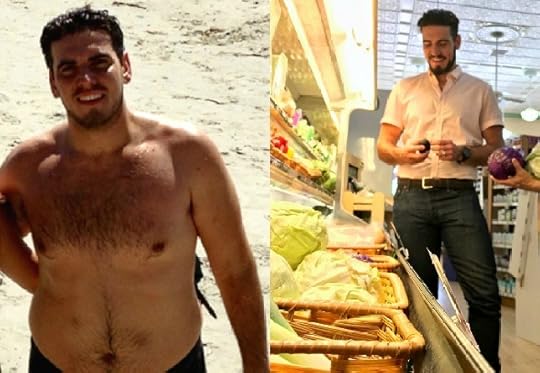

The post It Took Me Under a Year To Lose 100 Pounds appeared first on Mark's Daily Apple.



August 9, 2018
Mark’s Resistance Band Workout at Home
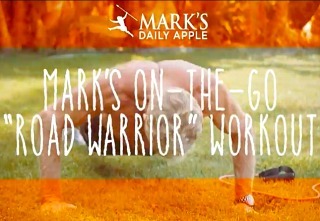 I hear people say all the time they don’t work out because they can’t make it to the gym or they don’t have the right equipment. Or (the big one)…they don’t have time. As someone who’s always on-the-go, I know I have to make my workouts fit my lifestyle. For me, that means having options I can do anywhere with minimal equipment and a short time investment.
I hear people say all the time they don’t work out because they can’t make it to the gym or they don’t have the right equipment. Or (the big one)…they don’t have time. As someone who’s always on-the-go, I know I have to make my workouts fit my lifestyle. For me, that means having options I can do anywhere with minimal equipment and a short time investment.
This “Road Warrior” workout is exactly that. If you have a resistance band (you can pick a set at Amazon for under $20 easily) and a floor, you’re set. It’s the ultimate do anywhere, no excuses routine. Check it out.
Resistance Band Pull-Apart Warm-Up (Front and Back)

Do 10 pulls behind the head.

Do 10 in front.
Side Delt Raises

Stepping on the middle of the resistance band with one foot, pull the handles up at your sides. Do 10 raises.
Front Delt Raises
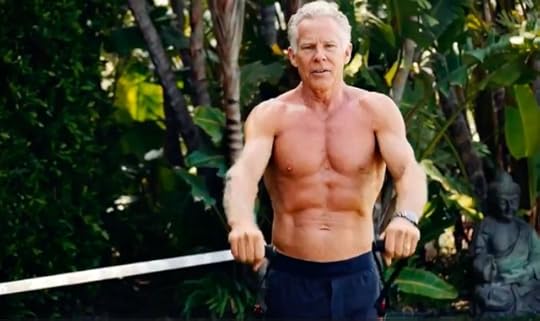
Keeping your foot on the band, this time pull the handles up in front of your body. Do 10 raises.
Air Squats
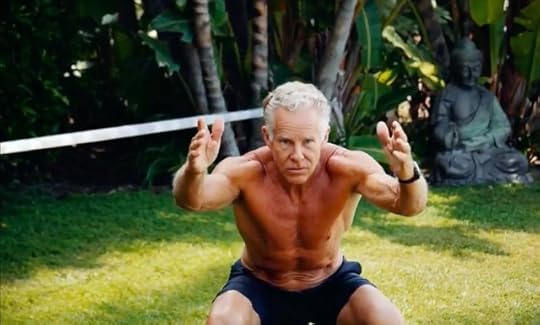
Step your feet shoulder-width apart. Keeping your back straight, squat as you bring your hands to the front each time. Do 25 squats.
Pushups

Drop and do 25 pushups.
Repeat the set four times.
Now you’re done. How’s that for simple?
Watch below for the full workout put together.
Let me know your thoughts on the video. Are you looking for more quick and easy workouts? Are you digging the video content? What are you doing for simple routines these days. Thanks for stopping by, everybody.

The post Mark’s Resistance Band Workout at Home appeared first on Mark's Daily Apple.



August 8, 2018
Alcohol While Keto?
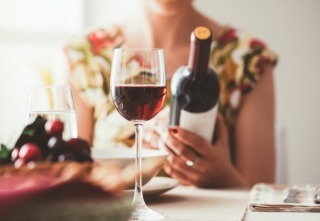 People like to get healthy, burn body fat, increase their aerobic capacity, and improve their cognitive function. The ketogenic diet is an excellent way to obtain those outcomes, which partially explains its meteoric rise in popularity. But people also like to drink alcohol. You might say it’s a toxin—I wouldn’t disagree. You might say we’d be better off without it—perhaps. The fact remains that people have been drinking for tens of thousands of years, and they’re not going to stop anytime soon.
People like to get healthy, burn body fat, increase their aerobic capacity, and improve their cognitive function. The ketogenic diet is an excellent way to obtain those outcomes, which partially explains its meteoric rise in popularity. But people also like to drink alcohol. You might say it’s a toxin—I wouldn’t disagree. You might say we’d be better off without it—perhaps. The fact remains that people have been drinking for tens of thousands of years, and they’re not going to stop anytime soon.
Can keto and alcohol coexist? Is there anything we need to take into consideration?
First things first, does alcohol inhibit ketosis?
There are very few human studies that even look at this issue. Let’s go over the best one I could find.
How Does High Intake of Alcohol Affect Ketosis?
A 2002 study out of Poland examined the bodies of 16 recently deceased people who had died from hypothermia, mostly alcohol-induced. Most were alcoholics. They found that ketone levels and blood-alcohol levels were inversely proportional. The higher the blood alcohol, the lower the ketones. The higher the ketones, the lower the blood alcohol. In the discussion section, the authors explain:
Liver cells ‘‘engaged’’ in ethanol utilization do not accumulate larger amounts of Ac-CoA (which is a substrate for ketogenesis) because an increase in the NADH/NAD ratio during ethanol oxidation inhibits b-oxidation of fatty acids, and the acetate created from ethanol is activated to AcCoA mainly in the non-liver tissues which cannot produce ketone bodies.
In other words, at a high enough intake, alcohol metabolism supersedes and inhibits ketogenesis because both processes occur in the liver along similar pathways. The Polish study is an extreme example—alcoholics, hypothermia, death—but the basic mechanism is sound.
What About Normal (Moderate) Intake?
In real world situations, however, where people are having a drink or two, low-sugar alcohol (red wine, spirits) is unlikely to derail ketosis. Sugary drinks will inhibit ketosis because of the sugar. Alcohol-induced junk food bingeing will inhibit ketosis because of the junk you’re eating. But it appears to take some serious doses of ethanol to make a noticeable dent in your ketone production. Even then, a degree or two less ketosis isn’t the end of the world (unless you have a serious health condition warranting constant ketosis, in which case are you sure you should be drinking?).
A friend of mine, Mark Moschel, is the health evangelist for Dry Farm Wines and an avid keto dieter and self-experimenter. He recently ran an interesting experiment to determine the effects of his low-sugar dry-farmed wines on ketosis. (If you’re a numbers junkie and love charts, you’ll appreciate seeing how he put it together.)
He fasted for three days to get deep into ketosis. Two days in, he opened a bottle of wine and started drinking.
After the first glass, there was no change. Ketones and blood sugar held steady.
After the second glass, ketones dropped a bit. Sugar rose a bit.
After the third, ketones dropped some more. Sugar went down this time.
Yet, at no point was he “out of ketosis.” Even after the third glass, he was still showing 1.4 mmol. And upon waking the next morning, he had bounced back to 2.3 mmol. By the afternoon, ketones were back above 4 mmol.
Something tells me the “3-day wine fast” is going to catch on in some circles….
Are There Any Negative Interactions Between Alcohol Consumption and Ketogenic Diets?
Maybe. A commonly reported side effect that hasn’t been shown in studies (because the studies haven’t been done) is reduced alcohol tolerance on keto. People report getting drunk quicker and having worse hangovers. Let’s assume for the sake of this post that it’s true, that the anecdotes are conveying something that’s actually happening to a large portion of the keto-eating world. What could be causing reduced alcohol tolerance?
Crowded CYP2E1 Pathway
Alcohol detoxification occurs along two enzymatic pathways, one of which—the CYP2E1 pathway—is also activated by ketone bodies. The CYP2E1 pathway is ultimately a detox pathway, but some of the metabolites it produces in response to the various toxins it processes, like alcohol, acetaminophen (Tylenol), and tobacco, can increase liver inflammation and peroxidative damage. If the ketones you’re making are triggering CYP2E1, drinking alcohol may put you over the top and push you toward greater oxidative stress.
This could explain part of the reason why drinking on an empty stomach (fasting, hence elevated ketones) tends to heighten the toxicity and enhance the hangover.
Excessive Omega-6 Fatty Acid Intake
A high-fat diet can very quickly become a high-omega-6 fat diet if you aren’t careful about the foods you’re eating. You’re eating out for lunch every day at Chipotle; it’s low carb, but everything is cooked in rice bran oil. You’re snacking on almonds and sunflower seeds. Your favorite meat is whole chicken with the skin on, and you use the chicken drippings to cook up a bunch of greens. The more fat, the better, right?
All those foods are moderately-to-very high in omega-6. If that’s a daily diet, you’re getting upwards of 30+ grams of omega-6 fats, mostly linoleic acid. Why is this a problem specifically in the context of alcohol?
Omega-6 fatty acids, especially linoleic acid, are particularly harmful when you drink alcohol:
Increased intestinal inflammation and leaky gut.
Increased chance of liver cirrhosis.
Induces fatty liver.
Polyunsaturated fats combined with alcohol also raise CYp2E1 more than alcohol alone, an indication of the combination’s toxicity.
Saturated fats, such as cocoa butter, coconut oil, and monounsaturated fats, such as avocado oil, olive oil, are far better in the context of alcohol.
Inadequate Choline Intake
High-fat diets are liver-intensive. The more fat you eat, the more choline you need to help metabolize it. High-fat diets with inadequate choline can lead to fatty liver, even if you’re eating the most Primal-friendly balanced source of fats.
Alcohol is also liver-intensive. The more alcohol you drink, the more choline you need to help metabolize it. High-alcohol diets with inadequate choline almost always lead to fatty liver, even if you’re drinking the healthiest, purest sources of ethanol.
Combining alcohol and a high-fat ketogenic diet requires even more choline than either alone. The best sources of choline are egg yolks and liver. Make sure you’re eating enough of one or the other to support your liver.
Inadequate Intake Of Phytonutrient-Rich Plants
Whether it’s coffee, chocolate, ginger, turmeric, green tea, the phytonutrients within the wine itself, or even non-psychoactive cannabidiol in cannabis, most plants make alcohol less toxic. Keto dieters who drink should definitely eat some or all of these foods.
Alcohol consumption presents a few notable challenges to people following a ketogenic diet, but they aren’t by any means insurmountable. Provided you eat a good ketogenic diet—not too much omega-6, adequate choline, plenty of phytonutrients— and make good beverage choices, moderate amounts of alcohol shouldn’t throw you out of ketosis or pose any special threat to your health.
I know we have a lot of readers with considerable experience following a ketogenic diet. Have you noticed anything different about the effects of alcohol? Has drinking hit your harder? Has it inhibited ketosis for you? I’d love to hear your experiences.
For those who are interested in a keto-friendly option, Dry Farm Wines is what I drink (and have for the last two+ years). (For those of you who stopped by our keto cocktail hour at Paleo f(x), we were serving up Dry Farms Wines there.) Mark M. and his team are good people in my book, and they get what the Primal message (and keto living) is all about. In my estimation, they’re the perfect choice for keto dieters who want to drink good wine and limit the negative health ramifications of alcohol consumption.
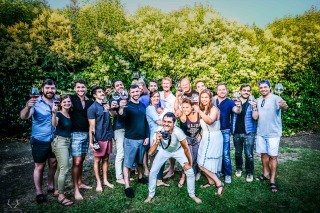 All their wines are lower in alcohol, 12.5% ABV or lower (validated by regular tests). Less alcohol, less toxicity.
All their wines are lower in alcohol, 12.5% ABV or lower (validated by regular tests). Less alcohol, less toxicity.
All their wines are also low in sugar, with a maximum of 1 gram per liter. A fourth of a gram of sugar per glass doesn’t make a difference.
All the wines are dry-farmed, meaning they’re less “washed out” from excessive watering, more complex, and more of the “grapeness” comes through in the finished product. That usually means a higher percentage of polyphenols as well, many of which mitigate the deleterious effects of consuming ethanol as mentioned above. If you’re interested, check ’em out.
In the interest of full disclosure, I’m a proud affiliate of theirs as well as a big fan. I only support and advertise a few companies on Mark’s Daily Apple that I thoroughly believe support healthy Primal living in the modern world. If it’s not in my kitchen, it’s not on my blog.
Have a great day, everybody. Take care and Grok on.

The post Alcohol While Keto? appeared first on Mark's Daily Apple.



Making a Difference Together: Our Masterclass—Miami Beach Style
 I’m still riding the high of holding another Primal Health Coach Institute Masterclass event—this one in Miami Beach, July 27-29. A couple dozen Primal Health Coach Institute students, graduates, staff and I gathered to take a deep dive into ancestral health, coaching and business building (and paddle boarding!), and it was an incredibly inspiring experience.
I’m still riding the high of holding another Primal Health Coach Institute Masterclass event—this one in Miami Beach, July 27-29. A couple dozen Primal Health Coach Institute students, graduates, staff and I gathered to take a deep dive into ancestral health, coaching and business building (and paddle boarding!), and it was an incredibly inspiring experience.
If you’re not familiar, Primal Health Coach Institute is the first and preeminent ancestral health coaching school in existence. I co-founded the school with my business partner Aaron Fox a few years back with the vision to help 100 million people reclaim health and wellness through education and coaching. Our mission is to build a global network of well-trained coaches that deliver excellent health outcomes for clients. And I’m proud to say we’re doing just that.
We now have thousands of students that have passed through the program, and many of them are running successful businesses (see here, here, and here for starters). They’re helping others, making an impact, doing what they love, and making a living doing it. What’s better than that?
 My enthusiasm for the school, the work we’re doing there, and the people involved grows every day. I believe that collectively we really can make a difference. So, if you’ve ever wished that you could make more of an impact and do more meaningful work, if you’ve ever desired to turn your passion for health and wellness into a purpose-driven vocation, or if you feel called to spread the Primal message to others because you personally know the life-transforming power that it has, I hope you’ll consider joining our program and tribe, and helping us fulfill the mission.
My enthusiasm for the school, the work we’re doing there, and the people involved grows every day. I believe that collectively we really can make a difference. So, if you’ve ever wished that you could make more of an impact and do more meaningful work, if you’ve ever desired to turn your passion for health and wellness into a purpose-driven vocation, or if you feel called to spread the Primal message to others because you personally know the life-transforming power that it has, I hope you’ll consider joining our program and tribe, and helping us fulfill the mission.
To learn more you can download the short guidebook How to Become a Health Coach: 5 Steps to Embarking on a Career You Love. Or join me and Master Coach Christine Hassler on an upcoming webinar by registering here.
?

The post Making a Difference Together: Our Masterclass—Miami Beach Style appeared first on Mark's Daily Apple.



Mark Sisson's Blog
- Mark Sisson's profile
- 199 followers


